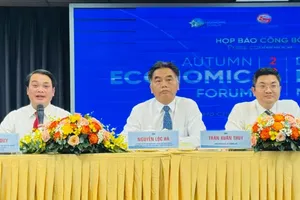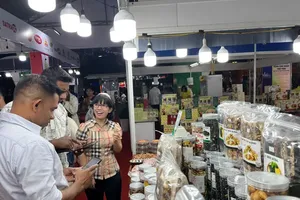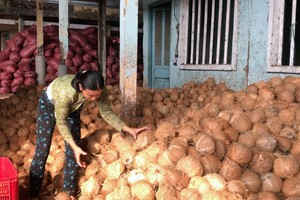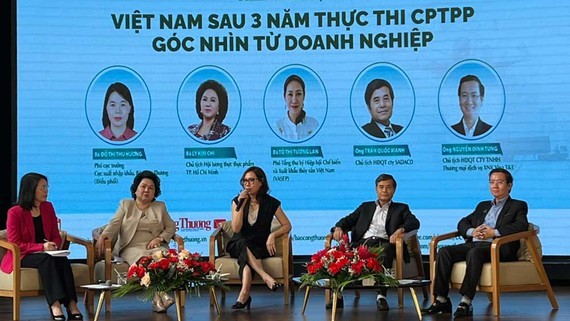 At the seminar. (Photo: SGGP)
At the seminar. (Photo: SGGP)
According to the Ministry of Industry and Trade, up to now, Vietnam has been participating in the negotiation and signing of 17 free trade agreements. Of these, three new-generation FTAs, namely the Comprehensive and Progressive Agreement for Trans-Pacific Partnership (CPTPP), the Vietnam - EU Free Trade Agreement (EVFTA), and the UK-Vietnam Free Trade Agreement (UKVFTA), have a broader scope. Besides commitments on trade, services, and investment, they also include legal and institutional arrangements. The implemented FTAs have had a strong impact on economic development as well as on the export of goods of Vietnam.
Specifically, for the CPTPP, after three years of implementation, Vietnamese businesses have taken advantage and relatively effectively exploit the benefits brought from the agreement. Vietnam's export turnover to this market in 2021 reached US$45.7 billion, up 18.1 percent compared to 2020. In the first ten months of 2022, it reached $38.8 billion, up 21.1 percent compared to the same period in 2021, and Vietnam recorded a trade surplus of $4.4 billion after ten months.
Similarly, after more than two years of implementing the EVFTA, Vietnam's exports to the EU have recorded positive results. Data from the General Department of Vietnam Customs show that in 2021, the two-way trade turnover between Vietnam and the EU reached $57.01 billion, up 14.5 percent over the same period in 2020. Of which, Vietnam's exports hit $1.1 billion, up 14.2 percent, and import value of $16.9 billion, up 15.3 percent over the same period in 2020. In the first ten months of 2022, the import and export turnover of goods between Vietnam and the EU topped $52.5 billion, up 14 percent compared to the same period last year. Of which, exports raked in $39.7 billion, up 23.5 percent.
Speaking at the seminar, Ms. Nguyen Thao Hien, Deputy Director of the European-American Market Department, assessed that, in general, Vietnam's exports to most EU markets recorded good growth and witnessed a positive transformation. Not only focusing on large markets and EU gateways, such as Germany, the Netherlands, and France, but exports are also gradually promoted to smaller markets, niche markets, such as Northern Europe, Eastern Europe, or Southern Europe.
The structure of export products to the EU also tends to expand and diversify when not only key commodities achieve impressive growth rates, but the export turnover of many agricultural, forestry, and fishery products is also increasing at an extremely high level, such as coffee with 43.4 percent, seafood with 31.6 percent, vegetables with 23.5 percent, and rice with 12.2 percent.
However, according to the Ministry of Industry and Trade, despite impressive results, the commitments and regulations in FTAs, especially the new generation FTAs, are relatively new and complicated, so many Vietnamese businesses are still confused and have not made the most of these incentives. Especially, in 2022, after nearly two years of fighting the pandemic, when economies and trade activities between countries normalize again, many countries begin to set higher standards for imported goods to protect domestic production as well as the health of consumers.
Therefore, in two discussion sessions at the seminar, the speakers and delegates discussed in order to identify the strengths and weaknesses in export currently, thereby putting forward solutions and policies to support the sustainable export development for enterprises to FTA markets in the coming time.
Specifically, for the CPTPP, after three years of implementation, Vietnamese businesses have taken advantage and relatively effectively exploit the benefits brought from the agreement. Vietnam's export turnover to this market in 2021 reached US$45.7 billion, up 18.1 percent compared to 2020. In the first ten months of 2022, it reached $38.8 billion, up 21.1 percent compared to the same period in 2021, and Vietnam recorded a trade surplus of $4.4 billion after ten months.
Similarly, after more than two years of implementing the EVFTA, Vietnam's exports to the EU have recorded positive results. Data from the General Department of Vietnam Customs show that in 2021, the two-way trade turnover between Vietnam and the EU reached $57.01 billion, up 14.5 percent over the same period in 2020. Of which, Vietnam's exports hit $1.1 billion, up 14.2 percent, and import value of $16.9 billion, up 15.3 percent over the same period in 2020. In the first ten months of 2022, the import and export turnover of goods between Vietnam and the EU topped $52.5 billion, up 14 percent compared to the same period last year. Of which, exports raked in $39.7 billion, up 23.5 percent.
Speaking at the seminar, Ms. Nguyen Thao Hien, Deputy Director of the European-American Market Department, assessed that, in general, Vietnam's exports to most EU markets recorded good growth and witnessed a positive transformation. Not only focusing on large markets and EU gateways, such as Germany, the Netherlands, and France, but exports are also gradually promoted to smaller markets, niche markets, such as Northern Europe, Eastern Europe, or Southern Europe.
The structure of export products to the EU also tends to expand and diversify when not only key commodities achieve impressive growth rates, but the export turnover of many agricultural, forestry, and fishery products is also increasing at an extremely high level, such as coffee with 43.4 percent, seafood with 31.6 percent, vegetables with 23.5 percent, and rice with 12.2 percent.
However, according to the Ministry of Industry and Trade, despite impressive results, the commitments and regulations in FTAs, especially the new generation FTAs, are relatively new and complicated, so many Vietnamese businesses are still confused and have not made the most of these incentives. Especially, in 2022, after nearly two years of fighting the pandemic, when economies and trade activities between countries normalize again, many countries begin to set higher standards for imported goods to protect domestic production as well as the health of consumers.
Therefore, in two discussion sessions at the seminar, the speakers and delegates discussed in order to identify the strengths and weaknesses in export currently, thereby putting forward solutions and policies to support the sustainable export development for enterprises to FTA markets in the coming time.

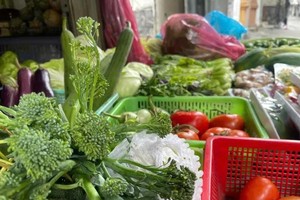

)










